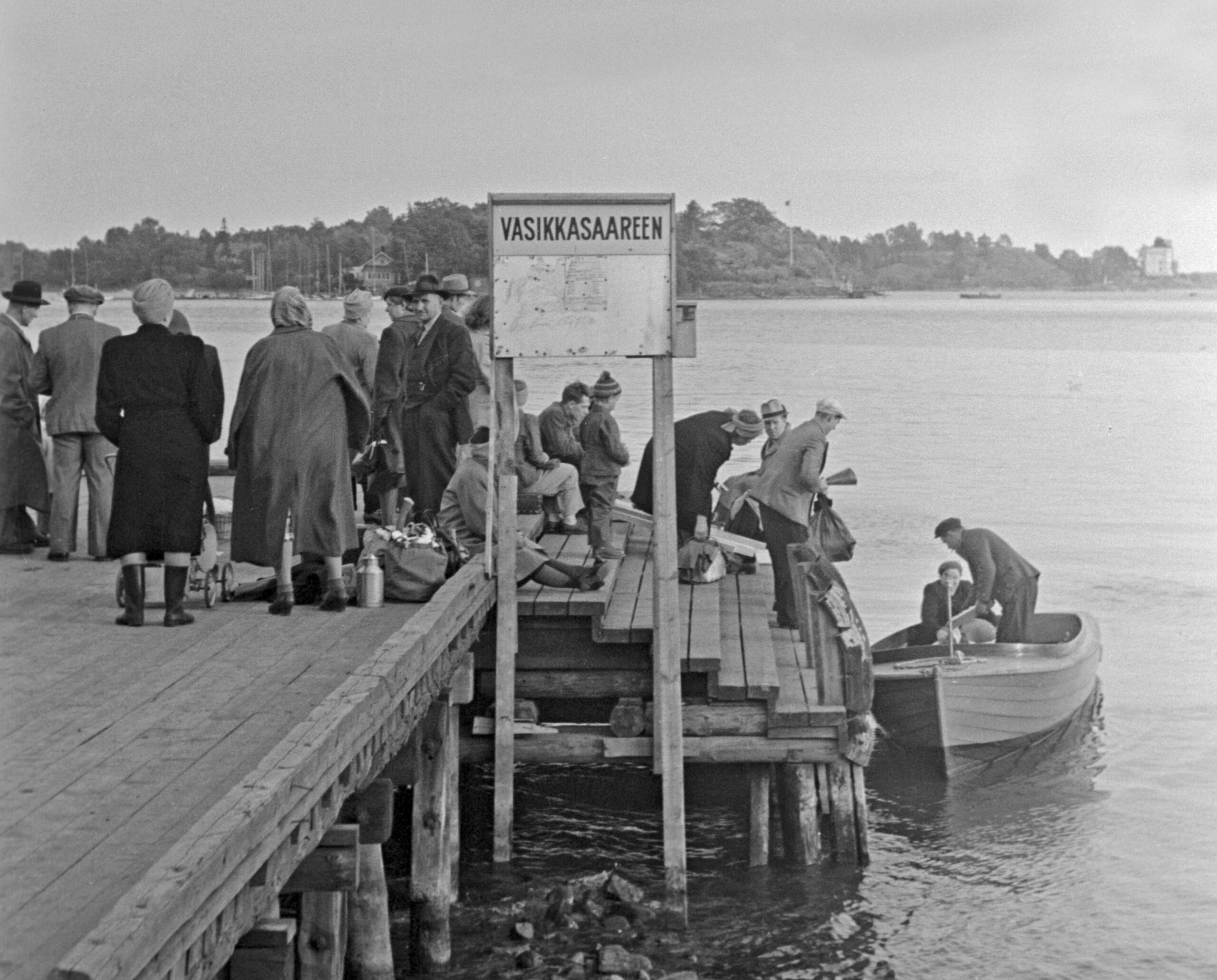Stages of Vasikkasaari
Calvholmen and Kalfholm were the first names of Vasikkasaari in mid-17th century, when it was part of the village of Santahamina. This name indicates that it was used as a pasture, as were several other islands in the Helsinki archipelago. The history of Vasikkasaari can be roughly divided into three different stages: Russian Vasikkasaari (1853–1918), Finnish Defence Forces’ Vasikkasaari (1918–1946) and summer cabin island (1946–), which have been described in more detail below.
In the 18th century, Vasikkasaari was still included in Suomenlinna’s fortification plans, but these plans were never implemented.
Russian Vasikkasaari
The Russian army started to build a storage facility on Vasikkasaari during the Crimean War, and Vasikkasaari’s brick buildings and stone structures date back to this time.
In 1863, Russians transported log warehouses to the island from Korkeasaari, Mustikkamaa and Taivallahti. The storage area in the middle of the island was surrounded by a stone wall. Planks were placed on top of the wall for guards to walk on while they guarded the buildings. The large brick guardhouse, ‘Commandant’s House’, was completed at the top of the island in 1870.
The storage area was expanded during the World War I. Most of the Russian navy was stationed in Helsinki during the war, and three large and two smaller fuel containers and a steam-powered pump room were built for them in the eastern parts of the island. Four smaller autocannon batteries were also built in Vasikkasaari, which were turned into AAW batteries in 1915.
A text carved into the rocks on the west shore stands as a reminder of the Russian times: ‘1898 byl v karau I. Sidorov’; in 1898, I stood guard, I.Sidorov.
Many plants counted as invasive species from Russia also remind us of the Russian era. Russian dock (Rumex confertus) and Vernal sedge (Carex praecox) grow on the rocky hill under the guardhouse.
Finnish Defence Forces’ Vasikkasaari
Many military goods were left behind the storage buildings on Vasikkasaari when they came into the possession of the Finnish government in 1918. The island housed a guard unit of soldiers.
Vasikkasaari was thoroughly destroyed in an explosion on 8 February 1919. A large container of naphtha exploded and caught fire, and, as a consequence, some ammo stored on the island started to explode, too. The explosion could be heard as far away as Tallinn and Heinola.
Five soldiers were guarding the island at the time, who all miraculously survived the explosion, though they required hospital treatment. Soldiers were injured also in Santahamina due to the breaking windows in barracks. Windows also broke in Suomenlinna, Katajanokka, Kaivopuisto and even further away.
The cause of this explosion remains unknown. There were several theories, including intentional destruction and covering up a theft. Furthermore, some Red Guard members still held as prisoners at Suomenlinna were hoping that Bolsheviks had come to release them.
The wooden buildings on Vasikkasaari were fully destroyed in the explosion. The brick guardhouse was also destroyed. The bad luck continued when a large quantity of oil leaked into the sea in April, and the negligent guard operations led to an internal legal dispute within the army. Oil was collected from the sea even at the shoreline of the Market Square.
Vasikkasaari was not used much after the explosion.
Summer cabins since 1946
In spring 1945, SKDL(the Finnish People’s Democratic League) requested a summer place by the sea in Santahamina from the Ministry of Defence. The Ministry did not agree to this at first, but, in the end, the island was rented out in 1947 despite the opposition of the navy.
Two families employed by the Defence Forces lived on the island, and the island also housed a large container of naphtha. It was rare for an island governed by the Defence Forces to become available to civilians. Similar summer homes were established on other army islands, too: Itä-Pihlajasaari was rented to Virkamiesliitto (the union of civil servants) and the Louesaari (Trutholm) was assigned for the use of the postal workers’ and telegraphy personnel’s union.
In 1953, a part of Vasikkasaari was rented to Valtion Virkailijain Liitto ry association for state officials. A fence was built between these two areas. at the beginning of the 1960s, there were 172 summer cabins on Vasikkasaari, most of them in SKDL’s area.
The island was rented from the Defence Forces, and only the cabin-owners and their guests were allowed to access the island.
The City of Helsinki acquired ownership of Vasikkasaari in 1963. The City wanted to clear the summer cabins from the island. The cabin owners turned to the Ministry of Defence and requested a new island for them to spend summers on. One was assigned to them on the northeast side of Handskholmen’s Eestiluoto in the outer sea zone. Several summer cabins were towed to the new island over water, and the army borrowed a large ferry for the transport. Six cabins were taken to Lammassaari and a few to Satamasaari.
The City granted extensions to the rental agreements of disabled and elderly people and finally allowed them to stay on Vasikkasaari. Today, there are 51 cabins on Vasikkasaari.
